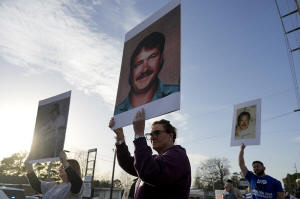A South Carolina man executed by firing squad is the first US prisoner
killed this way in 15 years
[March 08, 2025]
By JEFFREY COLLINS
COLUMBIA, S.C. (AP) — A South Carolina man who killed his
ex-girlfriend’s parents with a baseball bat was executed by firing squad
Friday, the first U.S. prisoner in 15 years to die by that method, which
he saw as preferable to the electric chair or lethal injection.
Three volunteer prison employees used rifles to carry out the execution
of Brad Sigmon, 67, who was pronounced dead at 6:08 p.m.
Sigmon killed David and Gladys Larke in their Greenville County home in
2001 in a botched plot to kidnap their daughter. He told police he
planned to take her for a romantic weekend, then kill her and himself.
Sigmon's lawyers said he chose the firing squad because the electric
chair would “cook him alive,” and he feared that a lethal injection of
pentobarbital into his veins would send a rush of fluid and blood into
his lungs and drown him.
The details of South Carolina's lethal injection method are kept secret
in South Carolina, and Sigmon unsuccessfully asked the state Supreme
Court on Thursday to pause his execution because of that.
On Friday, Sigmon wore a black jumpsuit with a hood over his head and a
white target with a red bullseye over his chest.
The armed prison employees stood 15 feet (4.6 meters) from where he sat
in the state’s death chamber — the same distance as the backboard is
from the free-throw line on a basketball court. Visible in the same
small room was the state’s unused electric chair. The gurney used to
carry out lethal injections had been rolled away.

The volunteers all fired at the same time through openings in a wall.
They were not visible to about a dozen witnesses in a room separated
from the chamber by bullet-resistant glass. Sigmon made several heavy
breaths during the two minutes that elapsed from when the hood was
placed to the shots being fired.
The shots, which sounded like they were fired at the same time, made a
loud, jarring bang that caused witnesses to flinch. His arms briefly
tensed when he was shot, and the target was blasted off his chest. He
appeared to give another breath or two with a red stain on his chest,
and small amounts of tissue could be seen from the wound during those
breaths.
A doctor came out about a minute later and examined Sigmon for 90
seconds before declaring him dead.
Witnesses included three family members of the Larkes. Also present were
Sigmon’s attorney and spiritual advisor, a representative from the
prosecuting solicitor's office, a sheriff's investigator and three
members of the news media.
Sigmon's lawyer read a closing statement that he said was “one of love
and a calling to my fellow Christians to help us end the death penalty.”
Prison spokeswoman Chrysti Shain said Sigmon’s last meal was four pieces
of fried chicken, green beans, mashed potatoes with gravy, biscuits,
cheesecake and sweet tea.
The firing squad is an execution method with a long and violent history
in the U.S. and around the world. Death in a hail of bullets has been
used to punish mutinies and desertion in armies, as frontier justice in
America’s Old West and as a tool of terror and political repression in
the former Soviet Union and Nazi Germany.

[to top of second column]
|

Protestors demonstrate outside the scheduled execution of South
Carolina inmate Brad Sigmon, Friday, March 7, 2025, in Columbia,
S.C. (AP Photo/Chris Carlson)

Since 1977 only three other prisoners in the U.S. have been executed
by firing squad. All were in Utah, most recently Ronnie Lee Gardner
in 2010. Another Utah man, Ralph Menzies, could be next; he is
awaiting the result of a hearing in which his lawyers argued that
his dementia makes him unfit for execution.
In South Carolina on Friday, a group of protesters holding signs
with messages such as “All life is precious” and “Execute justice
not people” gathered outside the prison before Sigmon's execution.
Supporters and lawyers for Sigmon asked Republican Gov. Henry
McMaster to commute his sentence to life in prison. They said he was
a model prisoner trusted by guards and worked every day to atone for
the killings and also that he committed the killings after
succumbing to severe mental illness.
But McMaster denied the clemency plea. No governor has ever commuted
a death sentence in the state, where 46 other prisoners have been
executed since the death penalty resumed in the U.S. in 1976. Seven
have died in the electric chair and 39 others by lethal injection.
Gerald “Bo” King, chief of the capital habeas unit in the federal
public defender’s office, said Sigmon “used his final statement to
call on his fellow people of faith to end the death penalty and
spare the lives of the 28 men still locked up on South Carolina’s
death row.”
“It is unfathomable that, in 2025, South Carolina would execute one
of its citizens in this bloody spectacle,” King said in a statement.
“But South Carolina has ended the life of a man who has devoted
himself to his faith, and to ministry and service to all around him.
Brad admitted his guilt at trial and shared his deep grief for his
crimes with his jury and, in the years since, with everyone who knew
him.”
In the early 2000s, South Carolina was among the busiest death
penalty states, carrying out an average of three executions a year.
But officials suspended executions for 13 years, in part because
they were unable to obtain lethal injection drugs.
The state Supreme Court cleared the way to resume them in July.
Freddie Owens was the first to be put to death, on Sept. 20, after
McMaster denied him clemency. Richard Moore was executed on Nov. 1
and Marion Bowman Jr. on Jan. 31.

Going forward the court will allow an execution every five weeks.
South Carolina now has 28 inmates on its death row including two who
have exhausted their appeals and are awaiting execution, most likely
this spring. Just one man has been added to death row in the past
decade.
Before executions were paused, more than 60 people faced death
sentences. Many of those have either had their sentences reduced to
life or died in prison.
___
Associated Press writer Adrian Sainz in Memphis, Tennessee,
contributed.
All contents © copyright 2025 Associated Press. All rights reserved |